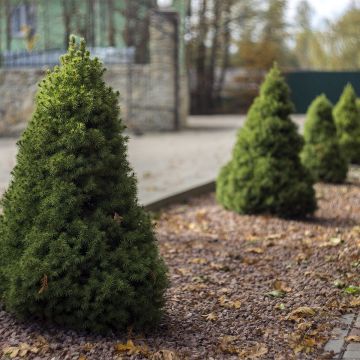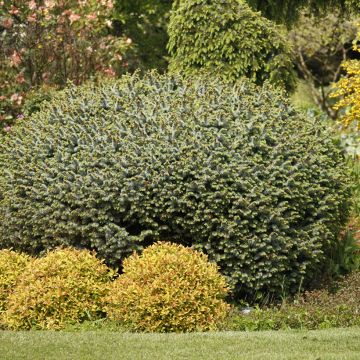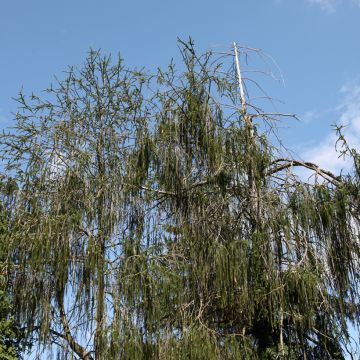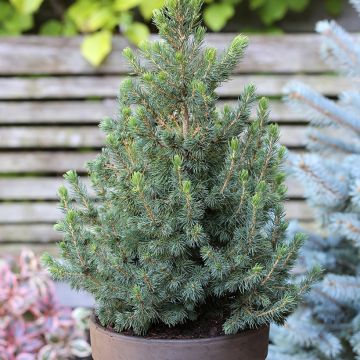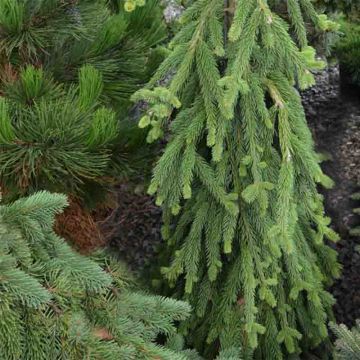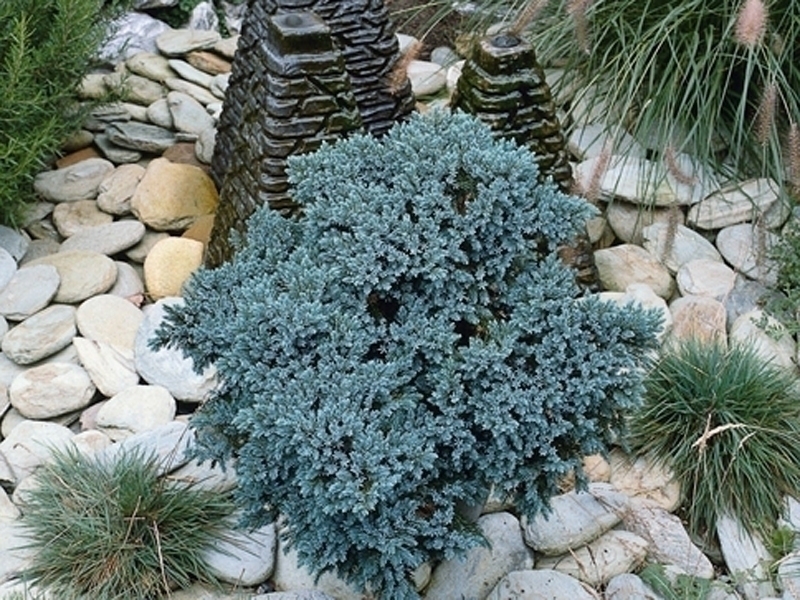

Picea pungens Kuba - Epicea bleu
Picea pungens Kuba - Blue Spruce
Picea pungens Kuba
Blue Spruce, Colorado Blue Spruce, Colorado Spruce, Silver Spruce
It is already well developed and its colour is superb.
Josiane D., 22/05/2017
Special offer!
Receive a €20 voucher for any order over €90 (excluding delivery costs, credit notes, and plastic-free options)!
1- Add your favorite plants to your cart.
2- Once you have reached €90, confirm your order (you can even choose the delivery date!).
3- As soon as your order is shipped, you will receive an email containing your voucher code, valid for 3 months (90 days).
Your voucher is unique and can only be used once, for any order with a minimum value of €20, excluding delivery costs.
Can be combined with other current offers, non-divisible and non-refundable.
Why not try an alternative variety in stock?
View all →This plant carries a 24 months recovery warranty
More information
We guarantee the quality of our plants for a full growing cycle, and will replace at our expense any plant that fails to recover under normal climatic and planting conditions.

Would this plant suit my garden?
Set up your Plantfit profile →
Description
Picea pungens 'Kuba' is an authentic dwarf form of the blue spruce, originating from a sowing found in Poland. It is a rare and precious variety, which will delight collectors, and owners of small gardens. It slowly forms a small flattened ball, distinguished by its particularly vibrant blue foliage and a very dense structure. Its slow growth and particularly reduced size make it suitable for smaller spaces, for planting in rockeries, but also in flower beds, borders or pots. It thrives in full sun or partial shade, in well-drained, moist, neutral to acidic soil.
Originally from the west coast of the United States and the Rocky Mountains of North America, up to Canada, the Picea pungens, also known as the Colorado blue spruce, is a hardy evergreen conifer belonging to the pinaceae family. In its natural environment, it grows slowly, presenting an elegant conical habit with horizontally layered branches. This tree can reach a height of 25 to 40 m (82 to 131 ft 2 in) and tolerates limestone soils and some drought.
The 'Kuba' variety, derived from this species, is a recent Polish creation, almost impossible to find for sale. It is a delightful small conifer, with a compact, initially rounded, then flattened cushion habit. Its growth is very slow, about 4 to 5 cm (1.6 to 2 in) in height and width each year. After 10 years, it will reach 40 cm (15.7 in) in height and 60 cm (23.6 in) in spread, depending on growing conditions. When mature, it will reach approximately 60 cm (23.6 in) in height and 90 cm (35.4 in) in spread. It produces almost horizontal, dense, short and thick branches, stacked on top of each other. They are covered with very short and sharp needles, arranged in dense brushes on both sides of the branches. Its young spring shoots are a very bright silvery blue, then the foliage takes on a softer bluish hue.
The 'Kuba' Blue Spruce, with its compact and regular habit, very small size, low maintenance, and ease of cultivation, is a perfect plant for rockeries and terraces, or for border planting. It thrives in many situations, as long as the soil is well-drained and not too alkaline, and the exposure is sunny. This plant pairs well with large stones, geometric lines, and brickwork. It can be associated with spring or summer annuals, which will enhance its foliage. The architectural qualities of conifers naturally emerge in the design of a contemporary garden, which prefers the aesthetics of shapes, silhouettes, and textures over flowers. These plants structurally define a flower bed, mark pathways and border terraces, easily replacing the strong presence of trimmed boxwood or holly. They also blend well with heathers, wormwoods, or shrubby salvias, as well as ground cover plants like aubrietias and ceraistes, and flowering shrubs like gauras. The key is to play with volumes and colours.
Picea pungens Kuba - Blue Spruce in pictures


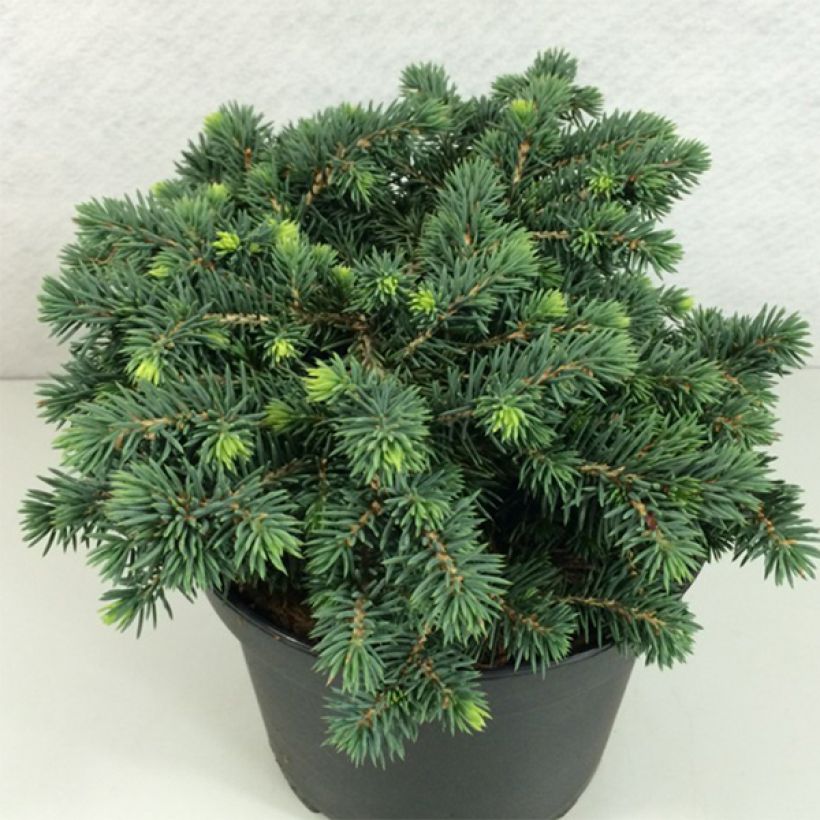

Plant habit
Foliage
Botanical data
Picea
pungens
Kuba
Pinaceae
Blue Spruce, Colorado Blue Spruce, Colorado Spruce, Silver Spruce
Cultivar or hybrid
Other Picea
View all →Planting and care
Picea pungens 'Kuba' is best planted from September to November and from February to June in fertile, well-drained, light, preferably neutral or slightly acidic soil that retains moisture. A sandy, loamy, or humus-rich soil will be perfect. Choose a sunny (or partially shaded) location, sheltered from prevailing winds. In overly wet conditions, it will be more susceptible to root rot. Soak the root ball well before planting. Apply organic fertilizer at planting and water generously in the first few years, especially during prolonged drought. Every year in April, apply a special conifer fertilizer and weed the soil in summer. This extremely hardy conifer dislikes heavy, waterlogged soils in winter. Pruning is not necessary as this cushion-shaped plant expresses its full potential when allowed to grow freely.
Planting period
Intended location
Care
Planting & care advice
-
, onOrder confirmed
Reply from on Promesse de fleurs
Similar products
Haven't found what you were looking for?
Hardiness is the lowest winter temperature a plant can endure without suffering serious damage or even dying. However, hardiness is affected by location (a sheltered area, such as a patio), protection (winter cover) and soil type (hardiness is improved by well-drained soil).

Photo Sharing Terms & Conditions
In order to encourage gardeners to interact and share their experiences, Promesse de fleurs offers various media enabling content to be uploaded onto its Site - in particular via the ‘Photo sharing’ module.
The User agrees to refrain from:
- Posting any content that is illegal, prejudicial, insulting, racist, inciteful to hatred, revisionist, contrary to public decency, that infringes on privacy or on the privacy rights of third parties, in particular the publicity rights of persons and goods, intellectual property rights, or the right to privacy.
- Submitting content on behalf of a third party;
- Impersonate the identity of a third party and/or publish any personal information about a third party;
In general, the User undertakes to refrain from any unethical behaviour.
All Content (in particular text, comments, files, images, photos, videos, creative works, etc.), which may be subject to property or intellectual property rights, image or other private rights, shall remain the property of the User, subject to the limited rights granted by the terms of the licence granted by Promesse de fleurs as stated below. Users are at liberty to publish or not to publish such Content on the Site, notably via the ‘Photo Sharing’ facility, and accept that this Content shall be made public and freely accessible, notably on the Internet.
Users further acknowledge, undertake to have ,and guarantee that they hold all necessary rights and permissions to publish such material on the Site, in particular with regard to the legislation in force pertaining to any privacy, property, intellectual property, image, or contractual rights, or rights of any other nature. By publishing such Content on the Site, Users acknowledge accepting full liability as publishers of the Content within the meaning of the law, and grant Promesse de fleurs, free of charge, an inclusive, worldwide licence for the said Content for the entire duration of its publication, including all reproduction, representation, up/downloading, displaying, performing, transmission, and storage rights.
Users also grant permission for their name to be linked to the Content and accept that this link may not always be made available.
By engaging in posting material, Users consent to their Content becoming automatically accessible on the Internet, in particular on other sites and/or blogs and/or web pages of the Promesse de fleurs site, including in particular social pages and the Promesse de fleurs catalogue.
Users may secure the removal of entrusted content free of charge by issuing a simple request via our contact form.
The flowering period indicated on our website applies to countries and regions located in USDA zone 8 (France, the United Kingdom, Ireland, the Netherlands, etc.)
It will vary according to where you live:
- In zones 9 to 10 (Italy, Spain, Greece, etc.), flowering will occur about 2 to 4 weeks earlier.
- In zones 6 to 7 (Germany, Poland, Slovenia, and lower mountainous regions), flowering will be delayed by 2 to 3 weeks.
- In zone 5 (Central Europe, Scandinavia), blooming will be delayed by 3 to 5 weeks.
In temperate climates, pruning of spring-flowering shrubs (forsythia, spireas, etc.) should be done just after flowering.
Pruning of summer-flowering shrubs (Indian Lilac, Perovskia, etc.) can be done in winter or spring.
In cold regions as well as with frost-sensitive plants, avoid pruning too early when severe frosts may still occur.
The planting period indicated on our website applies to countries and regions located in USDA zone 8 (France, United Kingdom, Ireland, Netherlands).
It will vary according to where you live:
- In Mediterranean zones (Marseille, Madrid, Milan, etc.), autumn and winter are the best planting periods.
- In continental zones (Strasbourg, Munich, Vienna, etc.), delay planting by 2 to 3 weeks in spring and bring it forward by 2 to 4 weeks in autumn.
- In mountainous regions (the Alps, Pyrenees, Carpathians, etc.), it is best to plant in late spring (May-June) or late summer (August-September).
The harvesting period indicated on our website applies to countries and regions in USDA zone 8 (France, England, Ireland, the Netherlands).
In colder areas (Scandinavia, Poland, Austria...) fruit and vegetable harvests are likely to be delayed by 3-4 weeks.
In warmer areas (Italy, Spain, Greece, etc.), harvesting will probably take place earlier, depending on weather conditions.
The sowing periods indicated on our website apply to countries and regions within USDA Zone 8 (France, UK, Ireland, Netherlands).
In colder areas (Scandinavia, Poland, Austria...), delay any outdoor sowing by 3-4 weeks, or sow under glass.
In warmer climes (Italy, Spain, Greece, etc.), bring outdoor sowing forward by a few weeks.






























